The AMD Ryzen 9 3950X Review: 16 Cores on 7nm with PCIe 4.0
by Dr. Ian Cutress on November 14, 2019 9:00 AM ESTCPU Performance: Web and Legacy Tests
While more the focus of low-end and small form factor systems, web-based benchmarks are notoriously difficult to standardize. Modern web browsers are frequently updated, with no recourse to disable those updates, and as such there is difficulty in keeping a common platform. The fast paced nature of browser development means that version numbers (and performance) can change from week to week. Despite this, web tests are often a good measure of user experience: a lot of what most office work is today revolves around web applications, particularly email and office apps, but also interfaces and development environments. Our web tests include some of the industry standard tests, as well as a few popular but older tests.
We have also included our legacy benchmarks in this section, representing a stack of older code for popular benchmarks.
All of our benchmark results can also be found in our benchmark engine, Bench.
WebXPRT 3: Modern Real-World Web Tasks, including AI
The company behind the XPRT test suites, Principled Technologies, has recently released the latest web-test, and rather than attach a year to the name have just called it ‘3’. This latest test (as we started the suite) has built upon and developed the ethos of previous tests: user interaction, office compute, graph generation, list sorting, HTML5, image manipulation, and even goes as far as some AI testing.
For our benchmark, we run the standard test which goes through the benchmark list seven times and provides a final result. We run this standard test four times, and take an average.
Users can access the WebXPRT test at http://principledtechnologies.com/benchmarkxprt/webxprt/
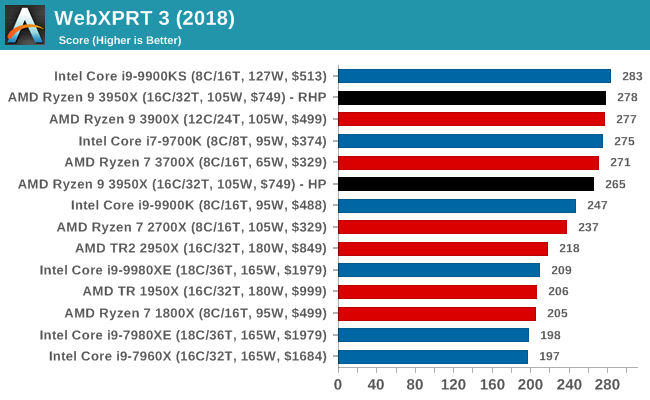
WebXPRT 2015: HTML5 and Javascript Web UX Testing
The older version of WebXPRT is the 2015 edition, which focuses on a slightly different set of web technologies and frameworks that are in use today. This is still a relevant test, especially for users interacting with not-the-latest web applications in the market, of which there are a lot. Web framework development is often very quick but with high turnover, meaning that frameworks are quickly developed, built-upon, used, and then developers move on to the next, and adjusting an application to a new framework is a difficult arduous task, especially with rapid development cycles. This leaves a lot of applications as ‘fixed-in-time’, and relevant to user experience for many years.
Similar to WebXPRT3, the main benchmark is a sectional run repeated seven times, with a final score. We repeat the whole thing four times, and average those final scores.
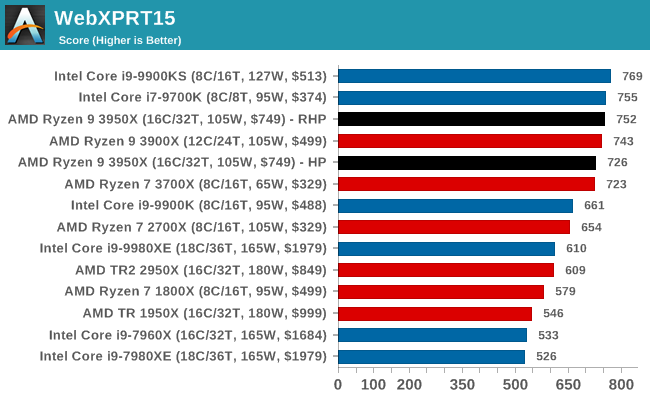
Speedometer 2: JavaScript Frameworks
Our newest web test is Speedometer 2, which is a accrued test over a series of javascript frameworks to do three simple things: built a list, enable each item in the list, and remove the list. All the frameworks implement the same visual cues, but obviously apply them from different coding angles.
Our test goes through the list of frameworks, and produces a final score indicative of ‘rpm’, one of the benchmarks internal metrics. We report this final score.
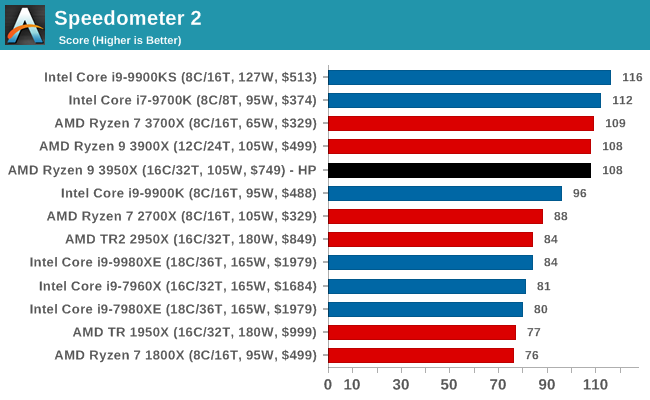
Google Octane 2.0: Core Web Compute
A popular web test for several years, but now no longer being updated, is Octane, developed by Google. Version 2.0 of the test performs the best part of two-dozen compute related tasks, such as regular expressions, cryptography, ray tracing, emulation, and Navier-Stokes physics calculations.
The test gives each sub-test a score and produces a geometric mean of the set as a final result. We run the full benchmark four times, and average the final results.

Mozilla Kraken 1.1: Core Web Compute
Even older than Octane is Kraken, this time developed by Mozilla. This is an older test that does similar computational mechanics, such as audio processing or image filtering. Kraken seems to produce a highly variable result depending on the browser version, as it is a test that is keenly optimized for.
The main benchmark runs through each of the sub-tests ten times and produces an average time to completion for each loop, given in milliseconds. We run the full benchmark four times and take an average of the time taken.

3DPM v1: Naïve Code Variant of 3DPM v2.1
The first legacy test in the suite is the first version of our 3DPM benchmark. This is the ultimate naïve version of the code, as if it was written by scientist with no knowledge of how computer hardware, compilers, or optimization works (which in fact, it was at the start). This represents a large body of scientific simulation out in the wild, where getting the answer is more important than it being fast (getting a result in 4 days is acceptable if it’s correct, rather than sending someone away for a year to learn to code and getting the result in 5 minutes).
In this version, the only real optimization was in the compiler flags (-O2, -fp:fast), compiling it in release mode, and enabling OpenMP in the main compute loops. The loops were not configured for function size, and one of the key slowdowns is false sharing in the cache. It also has long dependency chains based on the random number generation, which leads to relatively poor performance on specific compute microarchitectures.
3DPM v1 can be downloaded with our 3DPM v2 code here: 3DPMv2.1.rar (13.0 MB)
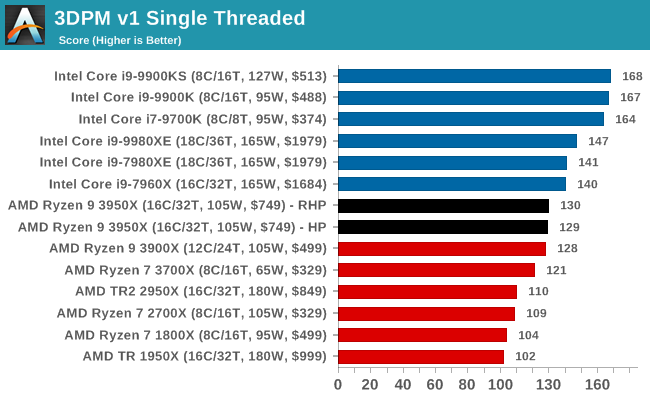
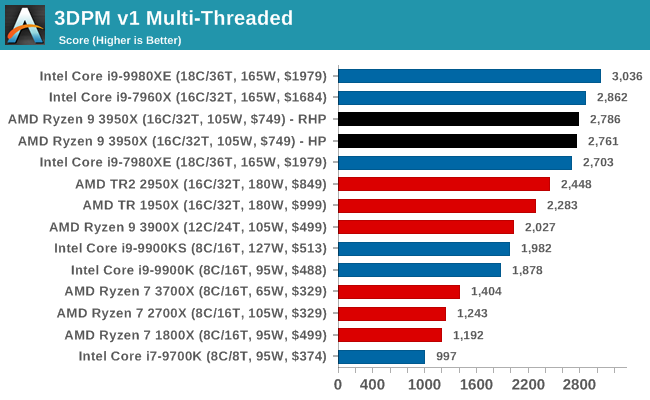
x264 HD 3.0: Older Transcode Test
This transcoding test is super old, and was used by Anand back in the day of Pentium 4 and Athlon II processors. Here a standardized 720p video is transcoded with a two-pass conversion, with the benchmark showing the frames-per-second of each pass. This benchmark is single-threaded, and between some micro-architectures we seem to actually hit an instructions-per-clock wall.
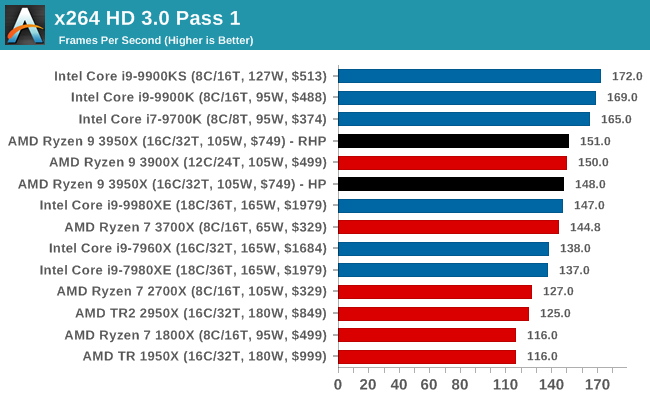
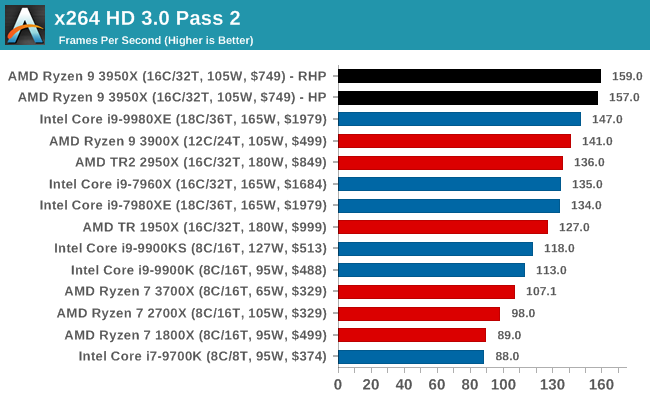
GeekBench4: Synthetics
A common tool for cross-platform testing between mobile, PC, and Mac, GeekBench 4 is an ultimate exercise in synthetic testing across a range of algorithms looking for peak throughput. Tests include encryption, compression, fast Fourier transform, memory operations, n-body physics, matrix operations, histogram manipulation, and HTML parsing.
I’m including this test due to popular demand, although the results do come across as overly synthetic, and a lot of users often put a lot of weight behind the test due to the fact that it is compiled across different platforms (although with different compilers).
We record the main subtest scores (Crypto, Integer, Floating Point, Memory) in our benchmark database, but for the review we post the overall single and multi-threaded results.

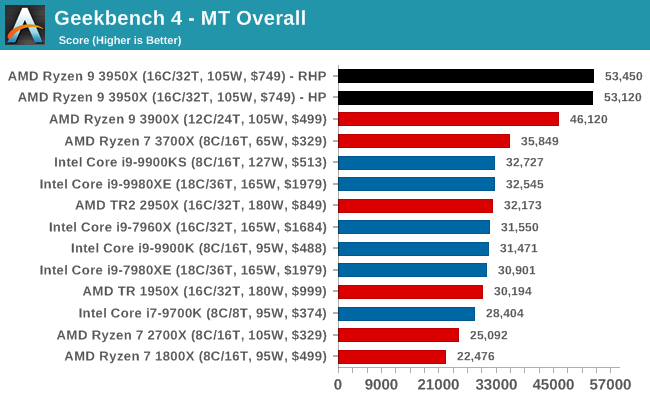










206 Comments
View All Comments
Ian Cutress - Thursday, November 14, 2019 - link
Different software was saying different values depending on which sensor. I'm going to go back at some point and see if I can figure out why some were +30C over others.eastcoast_pete - Thursday, November 14, 2019 - link
Thanks Ian! I agree that, right now, the 3950X is King of the Hill in the HEDT space. Two minor flies in the otherwise good Zen 2 ointment:1. To fit the 3950X into the target thermal envelope, AMD reserves the best 7 nm dies for the 3950X, at least for now (pending Threadripper). While that makes sense business wise, it means a much lower chance for the rest of us to score a great die in the binning lottery. The fun with earlier Zen chips was that one could, with some luck, get a great die in a mainstream chip. Apparently, no more. The mainstream Ryzens are still very good, but the idea of getting a little something extra added appeal.
2. AMD has advertised the 3950X as targeted for liquid cooling. I know a lot of those who buy it will do so anyway, but there are some "air heads" left, including this one. I look forward to a comparison of liquid vs high-end and mainstream air coolers.
Overall, a great chip, that will keep Intel running to catch up, and that's good for all of us!
hansmuff - Thursday, November 14, 2019 - link
Isn't (1) pure speculation? As far as (2) goes, even with the 3900X AMD was saying that the top frequencies need enhanced cooling, and that's not particularly true. Even on a good AIO, we're not seeing the 3900X performing better than on good air. The 3950X has similar thermal envelopes, so I think a good air cooler will be just dandy.eastcoast_pete - Thursday, November 14, 2019 - link
The binning part (1) was mentioned in an article in golem.de . That site is usually pretty reliable, despite their name.abufrejoval - Friday, November 15, 2019 - link
While it's one of my favorites, too, I doubt that in this specific case they have any insights AT lacks. I believe they editorialized that part.But of course sophisticated binning is a core part of the CPU business these days.
And another good one with exclusive news gems every now and then is this one: https://elchapuzasinformatico.com/
Irata - Thursday, November 14, 2019 - link
Does AMD consider the 3950X to be HEDT ? Thought it was part of their mainstream platform.Ratman6161 - Thursday, November 14, 2019 - link
No. the 3950x is not HEDT. Its performance blurs the lines a bit but HEDT is more than just the CPU. Its also about PCIe lanes and RAM capacity etc.Ratman6161 - Thursday, November 14, 2019 - link
"the 3950X is King of the Hill in the HEDT space"The 3950x is not in the HEDT space. That's one of the most important conclusions I take away from this review. 3950x runs on a regular desktop motherboard (albeit an x570 to get full advantage of it). So besides just the price of the CPU itself, it makes everything about the system less expensive as well. My conclusion is that the 3950X is the best overall performance you can get from something that is not HEDT. This makes it much more accessible to us mere mortals...though personally I'm still looking at the 3700X.
eastcoast_pete - Thursday, November 14, 2019 - link
I guess one person's high-end desktop is another one's mainstream. I call a CPU that, yes, costs more than twice than a standard 8 core, yet is also faster than many other "HEDT" CPUs HEDT. In my view, HEDT is still below workstation levels, which have all the goodies you mention such as many more PCIe lanes, quad or more memory channels, support error correcting memory and lots of it, and are often multi-socketed. But then, the prices for these is eye-watering. But, regardless, this is a fast CPU.phoenix_rizzen - Thursday, November 14, 2019 - link
Time for another category, then. :)This is definitely a high-end desktop CPU. Runs in a mainstream desktop motherboard, and performs better than pretty much every other mainstream desktop processor.
Maybe it's time to call the Intel -X and AMD Threafripper lines "workstation-class" or "high-end workstation" or something along those line.
So you get desktop, workstation, and server. With low-end/high-end sub-groups for them.
So Athlon 3000G and Ryzen 3 would be low-end desktop. Ryzen 5 and 7, and the APUs, would be normal desktop. Ryzen 9 would be high-end desktop.